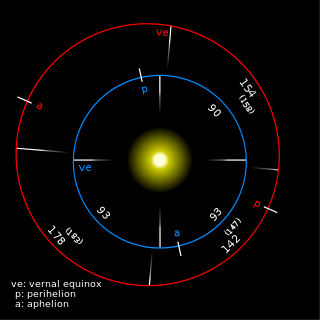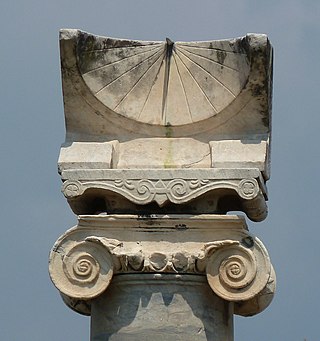A day is the time period of a full rotation of the Earth with respect to the Sun. On average, this is 24 hours. As a day passes at a given location it experiences morning, noon, afternoon, evening, and night. This daily cycle drives circadian rhythms in many organisms, which are vital to many life processes.

Greenwich Mean Time (GMT) is the local mean time at the Royal Observatory in Greenwich, London, counted from midnight. At different times in the past, it has been calculated in different ways, including being calculated from noon; as a consequence, it cannot be used to specify a particular time unless a context is given. The term GMT is also used as one of the names for the time zone UTC+00:00 and, in UK law, is the basis for civil time in the United Kingdom.

An hour is a unit of time historically reckoned as 1⁄24 of a day and defined contemporarily as exactly 3,600 seconds (SI). There are 60 minutes in an hour, and 24 hours in a day.

Right ascension is the angular distance of a particular point measured eastward along the celestial equator from the Sun at the March equinox to the point in question above the Earth. When paired with declination, these astronomical coordinates specify the location of a point on the celestial sphere in the equatorial coordinate system.

Sidereal time is a system of timekeeping used especially by astronomers. Using sidereal time and the celestial coordinate system, it is easy to locate the positions of celestial objects in the night sky. Sidereal time is a "time scale that is based on Earth's rate of rotation measured relative to the fixed stars".

In astronomy and celestial navigation, the hour angle is the dihedral angle between the meridian plane and the hour circle.
The 12-hour clock is a time convention in which the 24 hours of the day are divided into two periods: a.m. and p.m.. Each period consists of 12 hours numbered: 12, 1, 2, 3, 4, 5, 6, 7, 8, 9, 10 and 11. The 12-hour clock has been developed since the second millennium BC and reached its modern form in the 16th century.

The modern 24-hour clock is the convention of timekeeping in which the day runs from midnight to midnight and is divided into 24 hours. This is indicated by the hours passed since midnight, from 00(:00) to 23(:59), with 24(:00) as an option to indicate the end of the day. This system, as opposed to the 12-hour clock, is the most commonly used time notation in the world today, and is used by the international standard ISO 8601.

Midnight is the transition time from one day to the next – the moment when the date changes, on the local official clock time for any particular jurisdiction. By clock time, midnight is the opposite of noon, differing from it by 12 hours.

Midnight sun, also known as polar day, is a natural phenomenon that occurs in the summer months in places north of the Arctic Circle or south of the Antarctic Circle, when the Sun remains visible at the local midnight. When midnight sun is seen in the Arctic, the Sun appears to move from left to right. In Antarctica, the equivalent apparent motion is from right to left. This occurs at latitudes ranging from approximately 65°44' to exactly 90° north or south, and does not stop exactly at the Arctic Circle or the Antarctic Circle, due to refraction.

The equation of time describes the discrepancy between two kinds of solar time. The word equation is used in the medieval sense of "reconciliation of a difference". The two times that differ are the apparent solar time, which directly tracks the diurnal motion of the Sun, and mean solar time, which tracks a theoretical mean Sun with uniform motion along the celestial equator. Apparent solar time can be obtained by measurement of the current position of the Sun, as indicated by a sundial. Mean solar time, for the same place, would be the time indicated by a steady clock set so that over the year its differences from apparent solar time would have a mean of zero.

The Alaska Time Zone observes standard time by subtracting nine hours from Coordinated Universal Time (UTC−09:00). During daylight saving time its time offset is eight hours (UTC−08:00). The clock time in this zone is based on mean solar time at the 135th meridian west of the Greenwich Observatory.

In geography and geodesy, a meridian is the locus connecting points of equal longitude, which is the angle east or west of a given prime meridian. In other words, it is a line of longitude. The position of a point along the meridian is given by that longitude and its latitude, measured in angular degrees north or south of the Equator. On a Mercator projection or on a Gall-Peters projection, each meridian is perpendicular to all circles of latitude. A meridian is half of a great circle on Earth's surface. The length of a meridian on a modern ellipsoid model of Earth has been estimated as 20,003.93 km (12,429.87 mi).

Though no standard exists, numerous calendars and other timekeeping approaches have been proposed for the planet Mars. The most commonly seen in the scientific literature denotes the time of year as the number of degrees on its orbit from the northward equinox, and increasingly there is use of numbering the Martian years beginning at the equinox that occurred April 11, 1955.

Philippine Standard Time, also known as Philippine Time (PHT), is the official name for the time zone used in the Philippines. The country only uses a single time zone, at an offset of UTC+08:00, but has used daylight saving time for brief periods in the 20th century until July 28, 1990.

Daytime as observed on Earth is the period of the day during which a given location experiences natural illumination from direct sunlight. Daytime occurs when the Sun appears above the local horizon, that is, anywhere on the globe's hemisphere facing the Sun. In direct sunlight the movement of the sun can be recorded and observed using a sundial that casts a shadow that slowly moves during the day. Other planets and natural satellites that rotate relative to a luminous primary body, such as a local star, also experience daytime, but this article primarily discusses daytime on Earth.
Nautical time is a maritime time standard established in the 1920s to allow ships on high seas to coordinate their local time with other ships, consistent with a long nautical tradition of accurate celestial navigation. Nautical time divides the globe into 24 nautical time zones with hourly clock offsets, spaced at 15 degrees by longitudinal coordinate, with no political deviation.

Sun path, sometimes also called day arc, refers to the daily and seasonal arc-like path that the Sun appears to follow across the sky as the Earth rotates and orbits the Sun. The Sun's path affects the length of daytime experienced and amount of daylight received along a certain latitude during a given season.

The Gnomon of Saint-Sulpice is an astronomical measurement device located in the Church of Saint-Sulpice in Paris, France. It is a gnomon, a device designed to cast a shadow on the ground in order to determine the position of the sun in the sky. In early modern times, other gnomons were also built in several Italian and French churches in order to better calculate astronomical events. Those churches are Santa Maria del Fiore in Florence, San Petronio in Bologna, and the Church of the Certosa in Rome. These gnomons ultimately fell into disuse with the advent of powerful telescopes.

In Roman timekeeping, a day was divided into periods according to the available technology. Initially, the day was divided into two parts: the ante meridiem and the post meridiem. With the advent of the sundial circa 263 BC, the period of the natural day from sunrise to sunset was divided into twelve hours.

















